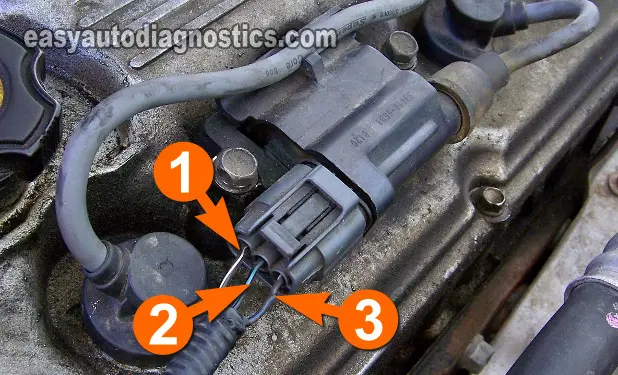
This is a step by step ‘how to test’ tutorial that will take you by the hand, so to speak, to diagnose and troubleshoot a misfire condition on your Suzuki or Chevrolet car or truck.
This article covers the Coil-On-Plug (C.O.P.) ignition coils on the 99 thru' 01 1.3L Suzuki Swift or 1.3L Chevy Metro or the 99 thru' 02 1.6L Suzuki Vitara or 1.6L Chevy Tracker.
Contents of this tutorial:
- Symptoms Of A Bad Coil-On-Plug Ignition Coil.
- What Tools Do I Need?
- Circuit Descriptions Of The C-O-P Ignition Coil Connector.
- Basic Operating Theory.
- Precautions, Do's And Don'ts.
- TEST 1: Spark Test.
- TEST 2: Testing The Power (12 V) Circuit.
- TEST 3: Testing The Ground Circuit.
- TEST 4: Triggering Signal Test.
- TEST 5: Testing For Spark At The Ignition Coil.
- TEST 6: Testing For Spark At The Ignition Coil.
- TEST 7: Misfire Due To Carbon Tracks.
- Related Articles.
Symptoms Of A Bad Coil-On-Plug Ignition Coil
When one or several ignition coils on your Suzuki Swift (or Vitara or Chevy Metro or Tracker) have gone bad, you'll know right away. Your vehicle will display one of the following symptoms:
- The car will run and idle rough.
- No power as you accelerate the car down the road.
- Really bad gas mileage.
- The vehicle will not start.
- The car will not run on all cylinders.
- Misfire codes that are lighting up the check engine light on your instrument cluster.
- P0300, P0301, P0302, P0303, P0304
- Rotten egg smell coming out of the tail-pipe.
What Tools Do I Need?
Testing the Coil-On-Plug (COP) ignition coils on your Suzuki Swift doesn't require any expensive testing equipment or expensive tools. Below is the list of tools that you'll need to successfully troubleshoot and diagnose a bad C.O.P ignition coil on your Swift:
- A 12 Volt automotive test light.
- A multimeter that can read Hz Frequency.
- An HEI spark tester
- This tool is a must have. To see what this tool looks like, click here: HEI Spark Tester.
- Battery jump start cables.
- Someone to help you crank the car.
Circuit Descriptions Of The C-O-P Ignition Coil Connector
Each Coil-On-Plug (COP) ignition coil on your Suzuki Swift has three wires coming out of them. In the image viewer photos you'll find the wires labeled with the numbers 1 thru' 3. Below you find our what each circuit does:
- Circuit labeled 1:
- 12 Volts
- Circuit labeled 2:
- Ground
- Circuit labeled 3:
- Triggering Signal Circuit.
The color of the wires is not important (to take advantage of the info in this article) as long as you're able to correctly identify the circuit by its number in the photos supplied.
Basic Operating Theory
As you might already know, this type of ignition system the ‘ignition control module’ function is handled by a transistor inside of the Coil-On-Plug ignition coil (both ignition coils have this transistor). The PCM (Powertrain Control Module=Fuel Injection Computer) is the one that controls the whole show. So, in a nutshell, here's what happens when you turn the key to crank and start the car:
- The engine starts to crank, inducing the crankshaft position (CKP) sensor to start producing its CKP signal.
- The Crank signal, upon being received by the PCM along with other necessary sensor information, starts to do its little song and dance and sends back a Triggering signal to each ignition coil.
- This Triggering signal contains the instructions for the Transistor (within each ignition coil) to start firing the ignition coil it's a part of.
- Each Coil-On-Plug (COP) ignition coil then fires spark to two different cylinders at the exact same time (in what's known as the Waste Spark method).
- One cylinder is fed spark directly by the ignition coil.
- The other cylinder is fed spark thru' a spark plug wire (high tension wire).
OK, technically speaking, this type of ignition system is not a true Coil-On-Plug (C.O.P.) system, but hey, if it kinda’ looks like a duck and kinda’ quacks like a duck -who cares? You're here to test them, not hold a debate about what category of ignition system they fit into.
Precautions, Do's And Don'ts
Most of the testing that you'll be doing is with the engine cranking, so take all necessary safety precautions to keep your fingers, hands and entire self safe. Here are a few other tips and suggestions:
- Do not use a regular spark plug instead of a spark tester to test for spark.
- Do not remove the spark plug wire from the spark plug or the ignition coil while the engine is cranking to test for spark.
- Start your diagnostic from TEST 1, do not skip around from test to test unless instructed to do so by the TEST you are currently on.
- Do not use a test light where an LED light is called for.
- Once again, use the recommended/indicated tools for all of your tests.



